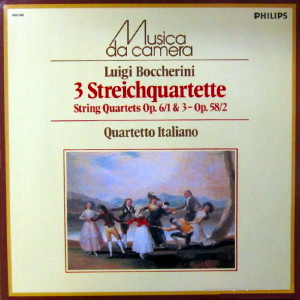 |
|
Philips
- 1 LP - 6503 060
|
|
QUARTETTO ITALIANO
- Paolo Borciani, Elisa Pegreffi, violino
- Piero Farulli,
viola
- Franco Rossi, violoncello |
|
|
|
|
|
Luogo e data
di registrazione |
|
Doopsgezinde
Kerk, Amsterdam
(Olanda) - 8-13
novembre 1976
|
|
|
Registrazione: live
/ studio |
|
studio |
|
|
Producer / Engineer |
|
Vittorio Negri |
Willem
van Leewen
|
|
|
Edizione LP |
|
Philips | 6503
060
| 1 LP |
|
|
Prima Edizione CD |
|
Vedi link alla prima
edizione in long playing.
|
|
|
Note |
|
La
collana
"Musica da
Camera" della
Philips
riedita negli
anni
'80
alcune
registrazioni
del Quartetto
Italiano. |
|
|
|
|
When Luigi
Boccherini, working from
Madrid, entered the
international music world
with his string quartets
and particularly his
string quintets, the
Rococo was flourishing in
Spain. The paintings of
the young Goya show a
lucid harmony of colours.
Human and social problems
had not yet entered his
canvases. Likewise,
Boccherini's chamber music
has none of the
psychological depths which
draw Mozart's quintets
into the spiritual centre
of his late chamber works.
Boccherini's compositions
represent entertainment
music in the best sense of
the word - entirely
centred on virtuoso
playing, dolcezza,
and the most delicate
colour and charm.
"As
a poem, as a
dream and a
perfume" was
how
Boccherini's
music appeared
in 1805 to the
French
easthete Chčnedollé.
Soon,
however, in
the Romantic
nineteenth
century, is
fell into
oblivion,
until in the
1870's the
famous Minuet
was
rediscovered,
and inundated
by a wave of
popularity. In
1895,
the Dresden
cellist
Friedrich Grützmacher
brought out
his very free
arrangement of
the Cello
Concerto in B
flat, and for
a long time
Boccherini was
generally know
- apart from
the Minuet -
solely as the
composer of
this work.
Only much
later did
musicians and
their
audiences
become aware
of the rich
treasure which
lay in the
many string
quartets and
quintets (with
two cellos).
The
string
quartets of
Op. 6 (this
according to
Boccherini's
own work
catalogue -
they are
designated Op.
8 in the
catalogue of
Yves Gérard,
published in
London in
1969) were
dedicated to
the Spanish
Infante Don
Luis and
printed in
Paris in 1769.
The following
year they
appeared in
London and
finally
probably in
1780, an
Amsterdam.
Delicacy
and
sensitivity
blend with
elements of galant
style in the
quartets of
Op. 6. Each
has three
movements, but
the form and
character of
the movements
and the
sequence in
which they
occur are
subject to no
fixed norm. In
the D major
Quartet Op.6
No. 1, an Allegro
vivace
with a
virtuoso
first-violin
part is
followed by an
affecting Adagio
in D minor,
and a graceful
Rondeau Allegro
in minuet
character. In
the E flat
Quartet Op. 6
No. 3, there
is an
introductory Largo
and the a Tempo
di Minuetto
and an Allegro.
In
Boccherini's
Op. 6 dolce
is the
frequently
encountered
expression
mark of a
Rococo art. So
too is the
indication lezioso
(daintly) over
a passage in
the first
movement of
the first
quartet.
Three
decades lie
between the
pubblication
of Op. 6 and
the six
quartets of
Op. 58, which
were issued in
Paris in 1799.
In all that
intervening
time,
Boccherini's
early
established
quartet style
underwent only
very slight
modifications.
In op. 58,
however, he
follows a new
path. Ludwig
Finscher
writing on
string
quartets in "Musik
in Geschichte
und
Gegenwart,"
traces the
orchestral richness
of sound, the
emotional
tension, and
the tendency
to extreme
effects
(semitone
progressions,
violent
dynamic
contrasts) to
the influence
of the music
of the French
Revolution on
quartet style
in general.
The E flat
Quartet, Op.
58 no. 2,
confirms this
total view of
Op. 58 in the
orchestral
tonal style of
many passages
and the close
justaposition
of stark forte
unisons and
light textured
piano
figures. The
minuet is
agitated by sforzati
on unaccented
beats, and the
closing Allegro
vivo assai
shows
some leanings
towards
contrapuntal
working.
Hans
Christoph Worbs
|
| Illustration:
Francisco de Goya y Lucientes
(1746-1826) "Blindekuh", um 1790
(Museo del Prado, Madrid)
|
|